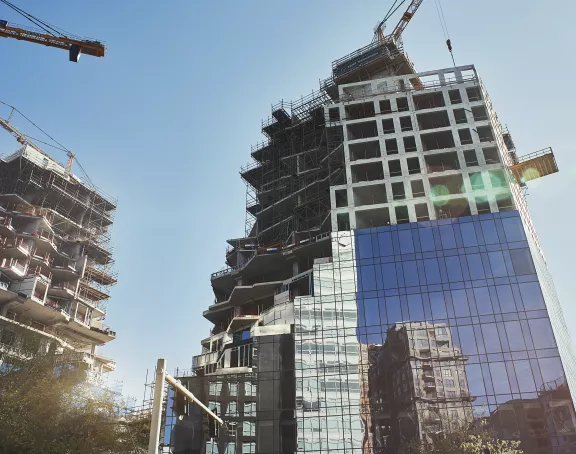Dutch Supreme Court rules that refurbishment of former woolen fabrics factory into retail center resulted in 'essentially new constructed real estate' for VAT purposes
On Friday 11 November 2022 the Dutch Supreme Court ruled that the refurbishment of a former woolen fabrics factory into a retail centre resulted in ‘essentially new constructed real estate’ (in wezen nieuwbouw) for Dutch VAT purposes. This an interesting ruling as it is the first time that the Dutch Supreme Court applied its interpretation of the concept ‘essentially new constructed real estate’ from its ruling of 4 November 2022 (see our blog post) to a specific case. According to the Dutch Supreme Court the refurbishment works entailed such significant changes to the structural construction that no other conclusion is possible than that the refurbishment of the former woolen fabrics factory resulted in ‘essentially new constructed real estate’ for Dutch VAT purposes.
In this blog post Ashley Peeters and Johan Vrolijk will discuss the ruling of the Dutch Supreme Court and the relevance for the Dutch real estate market.
Relevant facts
The case at hand concerns a factory complex that had not been in use since 1997 and had fallen into serious disrepair. In 1999 parts of the factory complex - i.e. a boiler house, a chimney and a factory hall that includes a 330 metre-long factory street - were listed in the national monument register. In 2009, the zoning of the factory complex was changed from 'industry' to 'industrial and retail'. In 2012 a real estate developer acquired the former factory complex and developed the complex in four building sections, designated A, B1, B2 and C, into a retail center.
The building sections A, B2 and C, which together made up 75% of the former factory complex, had been completely demolished and on site new buildings were constructed.
Building section B1 comprised all the above-mentioned parts of the factory complex which are protected as national monuments. The work carried out by the real estate developer in respect of building section B1 involved the following:
- At least one-third of the original 330-metre-long factory street was demolished at both ends so that 140 metres of it was retained. This part of the factory street was divided into ten compartments of 14 metres wide. Passages of ten metres wide were inserted in each compartment to form the entrances to the various shops.
- All internal walls were removed to improve the spatial effect and light penetration. These walls had a load-bearing function.
- The roof was completely renewed, retaining its characteristic shape.
- The cast iron columns were repaired or replaced by new ones if the old ones were too eroded.
- New steel structures were installed to increase the required load-bearing capacity for the new roof.
- The floor was largely renewed. The load-bearing capacity of the floor was increased from 400 kilograms per m2 to 1,000 kilograms per m2. Underneath the floor, the foundation was modified and replaced for this purpose.
- The roof and floor of the boiler house were completely replaced and new load-bearing structures were installed indoors.
An acquirer purchased the four building sections (A, B1, B2 and C) from the real estate developer in three phases.
In dispute
The dispute between the acquirer and the Dutch tax authorities concerns the question whether building section B1 qualifies as ‘essentially new constructed real estate’ for Dutch VAT purposes.
- The acquirer took the position that building section B1 qualifies as ‘essentially new constructed’ real estate for Dutch VAT purposes as result of which the transfer of building section B1 was by operation of law subject to Dutch VAT and the acquisition was exempt from RETT.
- The Dutch tax authorities took the position that the transfer of building section B1 did not qualify as ‘essentially new constructed real estate’ for Dutch VAT purposes. This is, because building section B1 had been renovated while maintaining the old features of the former woolen fabrics factory - such as the chimney, boiler house, shed roofs and factory street - and also the appearance of the former woolen fabrics factory was preserved. The change in function (from combined industry and retail function into retail function) was not considered relevant, because retail was already allowed under the zoning plan. Consequently, the transfer of building section B1 is exempt from VAT and subject to RETT.
Course of proceedings
On 26 February 2019 the Zeeland-West Brabant District Court ruled that given the nature and size of the refurbishment works carried out, it is plausible that the construction of building section B1 is amended in such a way that from a structural (bouwkundig) point of view essentially new real estate is constructed. Neither the fact that monumental aspects of the former woolen fabrics factory were retained, nor the fact that the appearance of that building was preserved, did according to the District Court alter its opinion that building section B1 qualifies as ‘essentially new constructed real estate’ for Dutch VAT purposes.
On 5 March 2020 the ‘s-Hertogenbosch Court of Appeal ruled that the refurbishment did not result in ‘essentially new constructed real estate’ for Dutch VAT purposes. To this end, the Court of Appeal considered that the work carried out was aimed at restoring or retaining the characteristic monumental features of building section B1 and that the work consisted of restoration, maintenance and repair work which, however significant, did not result in ‘essentially new constructed real estate’ (in wezen nieuwbouw). In this respect the Court of Appeal also took into account that building section B1 retained the identity of the former factory and that the building in its current form is still known by name of the old factory in the common parlance. In the Court of Appeal's opinion, the fact that business-economic as well as construction-technical choices have led to significant structural adjustments and related investments did not alter this.
On 3 January 2022 the Advocate General of the Dutch Supreme Court- gave her advisory opinion on how the Dutch Supreme Court should rule in the cassation proceedings. In the opinion of the Advocate General the fact that the load-bearing structure of building section B1 has been significantly changed, added to the size of the refurbishment costs (approx. 10 times the purchase price) and the change in function (woolen fabrics factory into retail center) cannot result in any other conclusion than that changes have been made that are of such a nature that the building section B1 qualifies as ‘essentially new constructed real estate’ for Dutch VAT purposes.
Supreme Court ruling
The Dutch Supreme Court ruled that the Court of Appeal has erred in law by not considering the significance of structural changes decisive in assessing whether new constructed real estate exists and reiterates its interpretation of the concept of ‘essentially new constructed real estate’ for Dutch VAT purposes from its 4 November 2022 ruling. According to the Dutch Supreme Court the refurbishment works entails such significant changes to the structural construction (bouwkundige constructie) that no other conclusion is possible than that the work performed resulted in an essentially new constructed building for VAT purposes. The Dutch Supreme Court confirms the ruling of the Zeeland-West-Brabant District Court.
Relevance for the Dutch real estate market
With this ruling the Dutch Supreme Court reiterates its ruling of 4 November 2022 that changes made to the structural construction (bouwkundige constructie) of a building are essential for the qualification as ‘essentially new constructed real estate’ for Dutch VAT purposes. Other criteria, such as change in function, external recognizability and size of the investments made and/or capital gains realized through the refurbishment, may be indications that the refurbishment was so significant that essentially a new building is constructed. However, these other criteria (alone or together) are neither decisive nor necessary.
Whether the changes to the structural construction are ‘so significant’ that essentially a new building is constructed, depends on the circumstances of the specific case. In the case at hand the Dutch Supreme Court concluded that the refurbishment of building section B1 was so significant that essentially a new building is constructed.
This open norm implies that at least the load-bearing construction - i.e., the part of the construction the structural failure of which results in the collapse of other parts of the buildings - should be amended. It will in practice however highly depend on the relevant facts and circumstances to what extent a change in the structural construction can justify the conclusion that a refurbishment was ‘so significant’ that this can be considered as ‘essentially new constructed real estate’ for Dutch VAT purposes. For instance, could the addition of a new storey to an existing building, which may lead to significant costs (and likely requires a change in the load-bearing capacity of the floor), already be considered as sufficiently significant changes in the structural construction of that building?
It is expected that in practice there may still be discussions with the Dutch tax authorities on the interpretation of this open norm. Especially since the Dutch Supreme Court in its ruling of 4 November 2022 stated that a refurbishment of an existing building will not be that easily considered so significant that an essentially new building is constructed, and thus has set the bar high.
Should you have any questions or need help in assessing whether an envisaged refurbishment of an existing building may result in an essentially new constructed building, please feel free to contact us.


